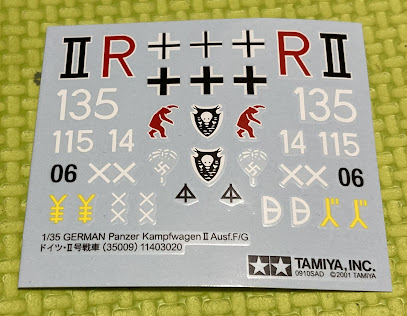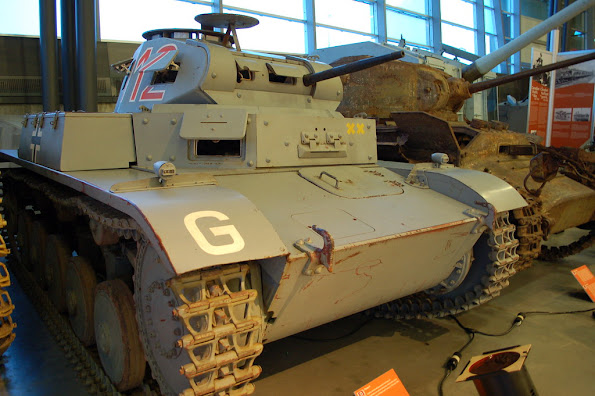Tamiya 1/35 Panzer II Ausf F/G . A perfect model for beginners. Let's see what you get for your money.
Tamiya 1/35 Panzer II Ausf F/G . A perfect model for beginners.

It's a simple image on the lid. One tank, five figures, no dinosaurs.
The Panzer II is the common name used for a family of German tanks used in World War II. The official German designation was Panzerkampfwagen II (abbreviated PzKpfw II). Thank you Wiki...
Although the vehicle had originally been designed as a stopgap while larger, more advanced tanks were developed, it nonetheless went on to play an important role in the early years of World War II, during the Polish and French campaigns. The Panzer II was the most numerous tank in the German Panzer divisions at the beginning of the war. It was used both in North Africa against the Western Allies and on the Eastern Front against the Soviet Union.
Not made any of those yet...

Purchasing information on the end panels along with a wonderful six dollar price tag.
Let's get in and see what we get. (You can slide the bands off but where's the fun in that?)

You always get a good box full but this kit is particularly generous. (Definitely no dinosaur though.)
Looking in a little more detail.
The hull comes in two parts. One little complaint is the suspension being part if the lower hull. Not a biggie in the final mix though. (What you going to do, glue them on..?)
Armour
The Panzer II was designed before the experience of the Spanish Civil War of 1936–39 showed that protection against armour-piercing shells was required for tanks to survive on a modern battlefield. Prior to that, armour was designed to stop machine gun fire and high-explosive shell fragments.
The Panzer II Ausf. A to C had 14 mm of slightly sloped homogeneous steel armour on the sides, front, and back, with 10 mm of armour on the top and bottom. Most of them were later given increased armour in the front of the vehicle, most noticeable by the changed appearance of the front hull from rounded to boxy shape. Starting with the D model, the front armour was increased to 30 mm. The Model F had 35 mm front armour and 20 mm side armour. This level of protection was still only proof against small arms fire. This amount of armour could be penetrated by towed anti-tank weapons, such as the Soviet 45mm, the British 2-pounder and the French canon de 47.
The turret gun and hull accessories...
Speaking of a gun...
Armament
Most tank versions of the Panzer II were armed with a 2 cm KwK 30 L/55 auto-cannon. Some later versions used the similar 2 cm KwK 38 L/55.[10] This auto-cannon was based on the 2 cm FlaK 30 anti-aircraft gun, and was capable of firing at a rate of 600 rounds per minute (280 rounds per minute sustained) from 10-round magazines. A total of 180 shells were carried. The Panzer II also had a 7.92 mm Maschinengewehr 34 machine gun mounted coaxially with the main gun.[6]
The 2 cm autocannon proved to be ineffective against many Allied tanks even at the start of the war, and experiments were conducted with a view to replacing it with a 37 mm cannon, but nothing came of this. Prototypes were built with a 50 mm tank gun, but by then the Panzer II had outlived its usefulness as a tank regardless of armament. Greater success was had by replacing the standard 2 cm armour-piercing explosive ammunition with tungsten cored solid ammunition, but due to shortages of tungsten this ammunition was in chronically short supply.
The wheels and the driver or should I say drivers. We really are getting our money's worth.
Crew
The Panzer II had a crew of three men. The driver sat in the forward left hull with the gearbox on the right. The commander sat in a seat in the turret, and was responsible for aiming and firing the cannon and co-axial machine gun, while a loader/radio operator sat on the floor of the tank behind the driver. He had a radio on the left and several 20mm ammunition storage bins.
The figures are showing their age, I think, But we are suipposed to be modellers at the end of the day. We should see whart we can do with what we are given before running to the aftermarket bits and pieces box.
The Panzer II was supplanted by the Panzer III and IV medium tanks by 1940/1941. By the end of 1942, it had been largely removed from front line service and it was used for training and on secondary fronts. The turrets of the then-obsolete Panzer Is and Panzer IIs were reused as gun turrets on specially built defensive bunkers, particularly on the Atlantic Wall. Production of the tank itself ceased by January 1944, but its chassis remained in use as the basis of several other armoured vehicles, chiefly self-propelled artillery and tank destroyers such as the Wespe and Marder II respectively.
They can always go in the spares box.
Tamiya decals usually go on ok. Never had any problem with them...(That's a lie, there's this star on the M3)
Those infamous rubber band tank tracks
Panzer II Ausf. F
Continuing the conventional design of the Ausf. C, the Ausf. F superstructure front was made from a single piece of armour plate with a redesigned visor. Also, a dummy visor was placed next to it to confuse enemy gunners. The hull was redesigned with a flat 35 mm (1.4 in) plate on its front, and the armour of the superstructure and turret were built up to 30 mm (1.2 in) on the front with 15 mm (0.59 in) to the sides and rear. There was some minor alteration of the suspension and a new commander's cupola as well. Weight increased to 9.5 tonnes. From March 1941 to July 1942, 509 were built; this was the final major tank version of the Panzer II series.
At my level. I have no problem wiith them,..
It's an old kit. 1971 don't you know.
The instructions...



















Comments
Post a Comment